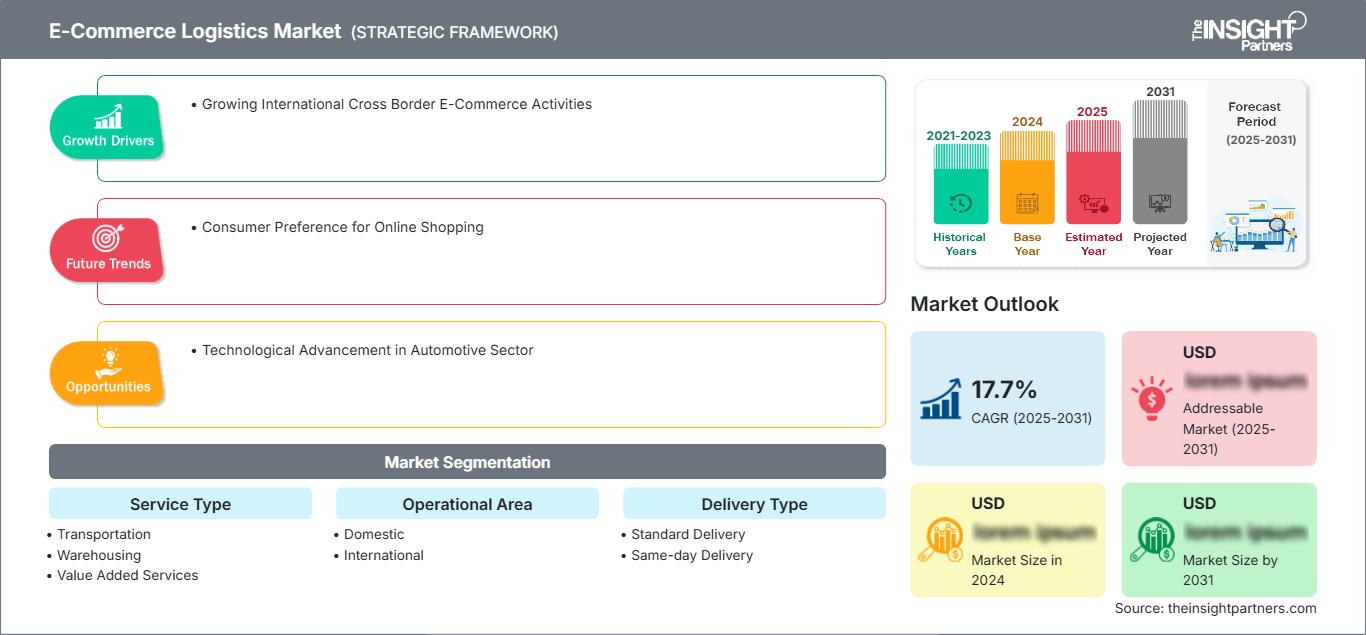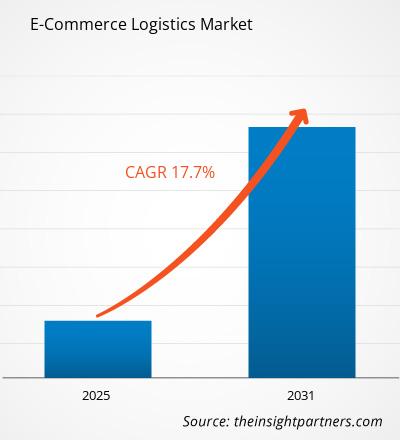页面已更新 :
Dec 2024
预计电子商务物流市场在 2025 年至 2031 年期间的复合年增长率为 17.4%,市场规模将从 2023 年的 XX 百万美元扩大到 2031 年的 XX 百万美元。
该报告按服务类型(运输、仓储、增值服务)细分;运营区域(国内、国际);配送类型(标准配送、当日配送);类别(服装和生活方式、汽车、书籍和期刊、工程、快速消费品和消费电子产品、医疗保健、高科技、其他);最终用户(B2B、B2C)。全球分析进一步细分为区域和主要国家。该报告为上述分析和细分提供美元价值。
报告目的
Insight Partners 撰写的《电子商务物流市场》报告旨在描述当前格局和未来增长、主要驱动因素、挑战和机遇。这将为各种业务利益相关者提供见解,例如:
- 技术提供商/制造商:了解不断变化的市场动态并了解潜在的增长机会,使他们能够做出明智的战略决策。
- 投资者:对市场增长率、市场财务预测和整个价值链中存在的机会进行全面的趋势分析。
- 监管机构:规范市场政策和警察活动,旨在最大限度地减少滥用,维护投资者的信任和信心,维护市场的完整性和稳定性。
电子商务物流市场细分服务类型
- 运输
- 仓储
- 增值服务;运营区域
配送类型
- 标准配送
- 当日送达
类别
- 服装与生活方式
- 汽车
- 书籍与期刊
- 工程
- 快速消费品与消费电子产品
- 医疗保健
- 高科技
- 其他
运营区域
- 国内
- 国际
最终用户
- B2B
- B2C
自定义此报告以满足您的要求
您将免费获得任何报告的定制,包括本报告的部分内容,或国家级分析、Excel 数据包,以及为初创企业和大学提供超值优惠和折扣
电商物流市场: 战略洞察

- 获取本报告的主要市场趋势。这个免费样本将包括数据分析,从市场趋势到估计和预测。
自定义此报告以满足您的要求
您将免费获得任何报告的定制,包括本报告的部分内容,或国家级分析、Excel 数据包,以及为初创企业和大学提供超值优惠和折扣
电商物流市场: 战略洞察

- 获取本报告的主要市场趋势。这个免费样本将包括数据分析,从市场趋势到估计和预测。
电商物流市场增长动力
- 电商销售蓬勃发展:网上购物的快速增长是电商物流市场的主要驱动力。随着越来越多的消费者转向数字平台购物,对高效、快速、可靠的物流解决方案的需求激增。这包括更快的配送时间、优化的库存管理和增强的最后一英里配送服务,所有这些都推动了物流行业的扩张。
- 技术进步:人工智能、机器人和自动化等技术创新正在改变电商物流。这些技术简化了仓储、库存管理和订单履行流程,提高了效率并降低了成本。用于路线优化和预测分析的人工智能驱动系统的集成进一步提高了运营绩效。
- 消费者对更快配送的需求:对更快配送(包括当日送达和次日送达)的期望日益增长,推动了对更高效物流网络的需求。为了满足这些需求,物流公司正在投资创新的配送模式和基础设施升级,例如微型配送中心,以提高速度和客户满意度。
电商物流市场未来趋势
- 全渠道配送的兴起:全渠道配送的趋势,即电商零售商同时提供线上和店内购买选项,正在重塑物流市场。零售商正在投资集成系统,以确保跨多个渠道的无缝配送,提升客户体验,并推动对同时满足电商和传统零售需求的先进物流解决方案的需求。
- 可持续性和绿色物流:可持续性正成为电商物流的重点。企业正在优先考虑环保实践,例如电动配送车辆、碳中和运输和减少包装。随着消费者环保意识的增强,物流供应商也在不断调整,以满足对更环保、更可持续的运输解决方案的需求。
电商物流市场机遇
- 最后一英里配送解决方案的扩展:最后一英里配送代表着电商物流领域的一个重要机遇。随着对更快配送速度的需求不断增长,无人机、自动驾驶汽车和本地配送中心等创新的最后一英里解决方案为物流公司提供了提高配送效率、降低成本和减少环境影响的机会。
- 跨境电商的增长:随着跨境电商的持续扩张,物流公司有机会进军国际市场。提供优化、可靠的运输解决方案,以应对海关、关税和全球运输挑战,可以帮助物流供应商充分利用全球电商服务日益增长的需求。
电子商务物流市场区域洞察
The Insight Partners 的分析师已详尽阐述了预测期内影响电子商务物流市场的区域趋势和因素。本节还讨论了北美、欧洲、亚太地区、中东和非洲以及南美和中美洲的电子商务物流市场细分和地理位置。
电子商务物流市场报告范围
| 报告属性 | 细节 |
|---|---|
| 市场规模 2024 | US$ XX million |
| 市场规模 2031 | US$ XX Million |
| 全球复合年增长率 (2025 - 2031) | 17.7% |
| 历史数据 | 2021-2023 |
| 预测期 | 2025-2031 |
| 涵盖的领域 |
By 服务类型
|
| 覆盖地区和国家 | 北美
|
| 市场领导者和主要公司简介 |
|
电子商务物流市场参与者密度:了解其对业务动态的影响
电子商务物流市场正在快速增长,这得益于终端用户需求的不断增长,而这些需求的驱动因素包括消费者偏好的演变、技术进步以及对产品优势的认知度的提升。随着需求的增长,企业正在扩展其产品线,不断创新以满足消费者需求,并利用新兴趋势,从而进一步推动市场增长。

- 获取 电商物流市场 主要参与者概述
主要卖点
- 全面覆盖:本报告全面涵盖了对电子商务物流市场的产品、服务、类型和最终用户的分析,提供了整体的市场格局。
- 专家分析:本报告基于对行业专家和分析师的深入了解而编写。
- 最新信息:本报告涵盖了最新信息和数据趋势,确保了其业务相关性。
- 定制选项:本报告可以根据特定客户需求进行定制,并使其与业务战略相得益彰。
因此,这份关于电子商务物流市场的研究报告可以帮助引领解读和理解行业情景和增长前景的线索。尽管可能存在一些合理的担忧,但本报告的总体优势往往大于劣势。
- 历史分析(2 年)、基准年、预测(7 年)及复合年增长率
- PEST和SWOT分析
- 市场规模、价值/数量 - 全球、区域、国家
- 行业和竞争格局
- Excel 数据集
近期报告
相关报告
客户评价
购买理由
- 明智的决策
- 了解市场动态
- 竞争分析
- 客户洞察
- 市场预测
- 风险规避
- 战略规划
- 投资论证
- 识别新兴市场
- 优化营销策略
- 提升运营效率
- 顺应监管趋势
我们的客户































87-673-9708

ISO 9001:2015



 获取免费样品 - 电商物流市场
获取免费样品 - 电商物流市场